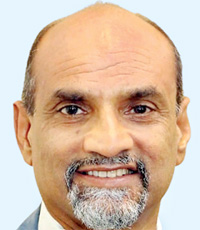Friday Nov 28, 2025
Friday Nov 28, 2025
Tuesday, 7 September 2021 02:14 - - {{hitsCtrl.values.hits}}

By Charumini de Silva
 |
| MAS Holdings Executive Director Shirendra Lawrence |
 |
| Hirdaramani Group Director Aroon Hirdaramani |
 |
| Star Garments Group Senior Manager – Business Analysis Jeevith Senaratne |
 |
| Brandix Moose Clothing Company Executive Director Hasib Omar
|
The apparel industry says the export target of $ 5.1 billion for 2021 would be a tough task, given the latest wave of COVID-19 in the country and companies operating 15% below capacity.
However, with key markets showing signs of bouncing back, the industry opined that there was hope, but keeping up with customer expectations remained a mounting challenge.
“The real benchmark we set ourselves as an industry is 2019. Considering the year-to-date (YTD) performance, we will end up with around $ 4.7-4.8 billion exports by the end 2021, which is still an improvement of about 30% compared to 2020, and leaves us 10% short of our $ 5.3 billion in 2019,” MAS Holdings Executive Director Shirendra Lawrence told a webinar recently.
The event titled ‘Be inspired by the pandemic: Resilient corporate success of Sri Lanka’s apparel industry,’ was organised by the American Chamber of Commerce (AMCHAM).
According to the Central Bank, textiles and garments exports in the first half of 2021 rose by 28% to $ 2.48 billion, whilst in June it improved by only 3% to $ 415.5 million. Of that, garments exports grew by 31% to $ 2.26 billion in 1H and by 17% to $ 376.6 million in June.
The webinar was told that apparel exports declined by 50% in Q2 of last year against the same period in 2019 due to the pandemic. The industry recovered partially by 20% by Q4 and ended the year with $ 4.1 billion exports compared to $ 5.3 billion in 2019. The net decline in apparel exports last year was 22%, perhaps a lot less than the industry expected in June 2020 after the first lockdown. The apparel sector’s contribution to the GDP was 16% and its input to the total exports was 43%.
Hirdaramani Group Director Aroon Hirdaramani said Sri Lanka is known as an ethical and reliable manufacturer internationally, and the country benefited from the healthy collaborations it had maintained over the year for the speedy revival of the industry.
“There has been a history of collaborations in our industry. A number of brands and retailers rely on Sri Lanka. We compete for the same customer, but we have a lot of collaborations with other trade associations and Government agencies. It is a good example for other industries as well. Sri Lanka’s apparel industry is leading when it comes to sustainability and innovation. These are aspects we need to be proud of,” he stressed.
The apparel industry includes a dynamic and growing raw material manufacturing sector including fabrics, accessories, etc. It is also the largest employer with 350,000 direct workers and over 750,000 indirect employees.
Hirdaramani also emphasised on building such strong collaborations over the years. “I think our foundation is strong, and hopefully we can build on it,” he added.
Lawrence also said the magnitude of change in the operating system has been significant. “We had to adopt best practices for the companies whilst focusing on a safe working environment, turning the entire production to cater to social distancing, establishing secure bio-bubbles, health checks, and enabling remote work wherever possible. Disciplinary endurance to these protocols and establishment of monitoring systems meant huge changes in behaviour,” he added.
Star Garments Group Senior Manager – Business Analysis Jeevith Senaratne said keeping up with the reputation of the customers, while maintaining the reputation as manufacturers who keep up to their commitments was becoming increasingly challenging with the latest COVID wave in the country.
“We are operating 10-15% below capacity because of COVID disruption that keeps coming on a regular basis. It is about how we control the surge at that point. There is hope, as our customer markets are open but meeting their expectations is challenging,” he added.
Lawrence also pointed out that it had been quite difficult to continue to operate without vaccinations in place for factory workers and close associates until four months ago.
The industry extended its gratitude to the Government and health authorities for arranging vaccinations against COVID-19, insisting that it was important to adhere to all health protocols.
“The Joint Apparel Association Forum’s (JAAF) proactive measures to get permission to vaccinate workers above 19 years allowed us to administer the first jab for around 90% in the industry and complete the second shot for around 70% of the workforce,” Brandix Moose Clothing Company Executive Director Hasib Omar said adding that the industry was adhering to all health protocols.
As of August, 90% of the apparel workforce has received first doses, and up to 50% have received their second doses. Swift progress is being made to complete vaccinating the entire workforce by the end of September 2021, according to JAAF.
Despite the extreme challenges and tough journey, they said everyone managed to pull through bravely.
As of yesterday, the country has had 465,949 COVID patients of which 69,120 are active cases. The death toll stood at 10,320 as of Sunday.